University Report: Management of Information Systems Analysis
VerifiedAdded on 2023/06/09
|11
|2163
|194
Report
AI Summary
This report provides an in-depth analysis of Management Information Systems (MIS) within the context of XYZ Systems, an IT management consultancy. It begins with an executive summary outlining the importance of IT functions and their relevance to the business. The report then details the current project, emphasizing the significance of MIS in data management, customer service, and information security. It proposes various IT functions, including cloud resources, and justifies their contribution to XYZ's business strategy. The report also explores the roles of different departments, such as management, HR, networking, security, and technical support, in implementing cloud solutions. Furthermore, it discusses the benefits of cloud computing, like shared resources, worldwide access, and cost reduction. The report concludes by highlighting the importance of IT departments becoming digital partners and adapting to the changing IT landscape, emphasizing the need for strategic repositioning to overcome internal skepticism and drive digital transformation. The report also includes a comprehensive list of references.
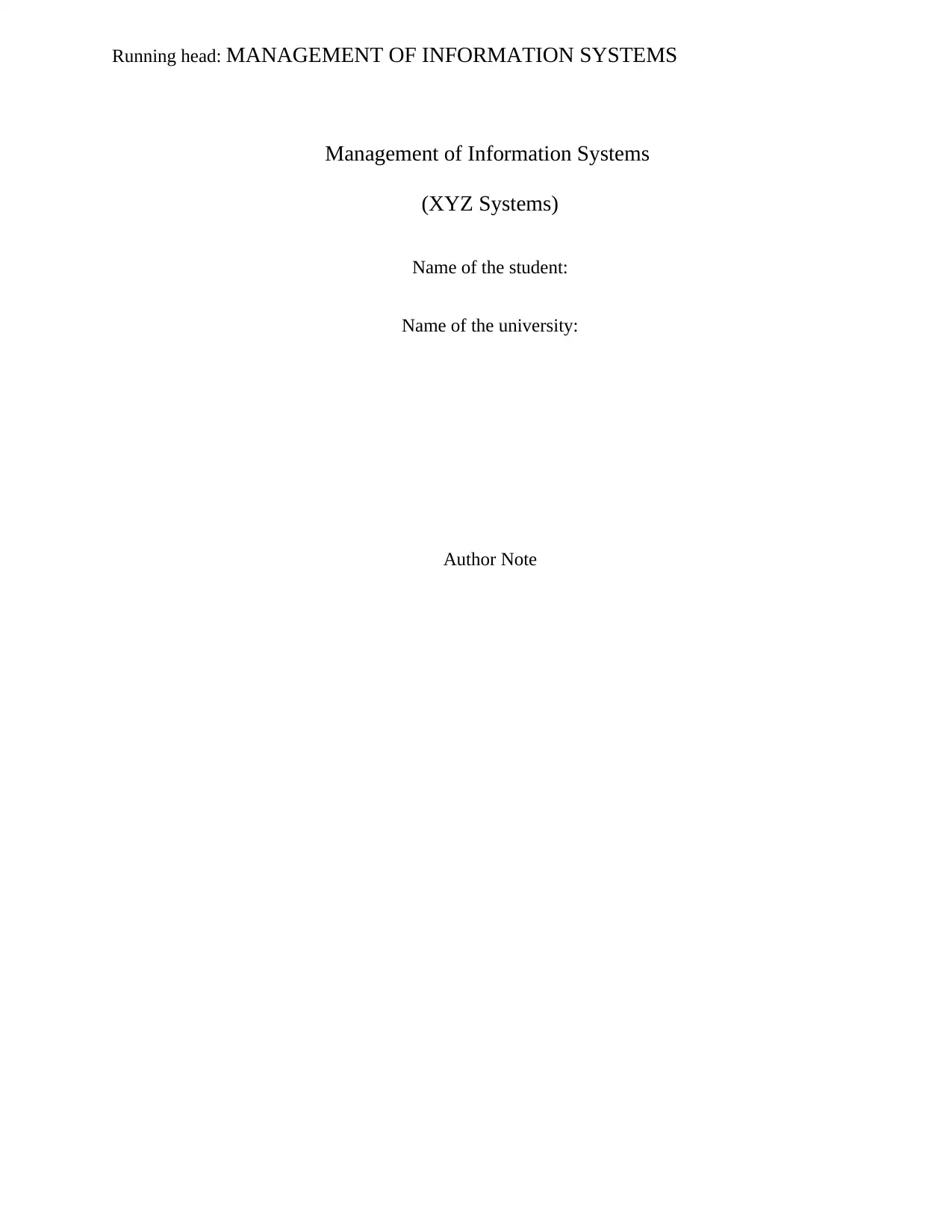
Running head: MANAGEMENT OF INFORMATION SYSTEMS
Management of Information Systems
(XYZ Systems)
Name of the student:
Name of the university:
Author Note
Management of Information Systems
(XYZ Systems)
Name of the student:
Name of the university:
Author Note
Paraphrase This Document
Need a fresh take? Get an instant paraphrase of this document with our AI Paraphraser
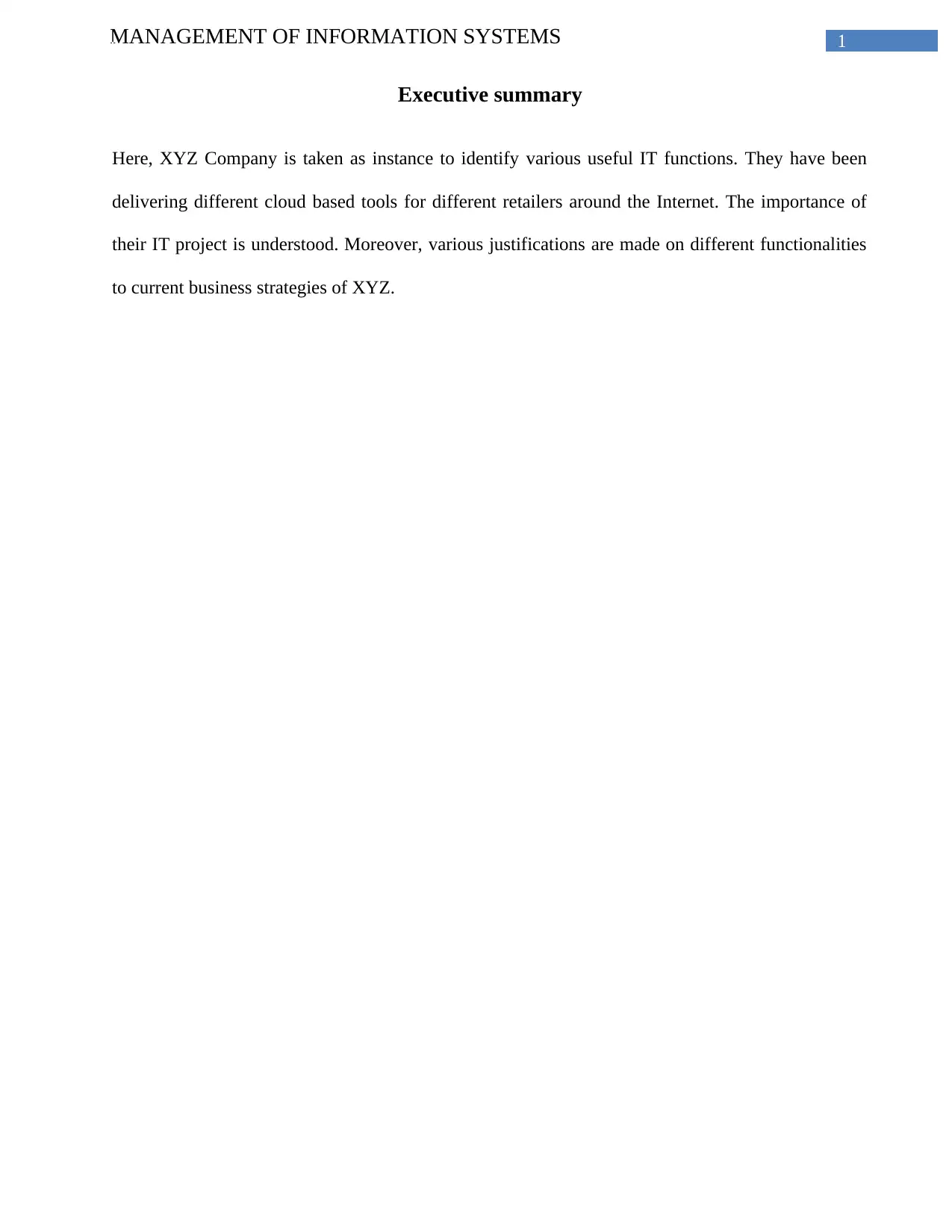
1MANAGEMENT OF INFORMATION SYSTEMS
Executive summary
Here, XYZ Company is taken as instance to identify various useful IT functions. They have been
delivering different cloud based tools for different retailers around the Internet. The importance of
their IT project is understood. Moreover, various justifications are made on different functionalities
to current business strategies of XYZ.
Executive summary
Here, XYZ Company is taken as instance to identify various useful IT functions. They have been
delivering different cloud based tools for different retailers around the Internet. The importance of
their IT project is understood. Moreover, various justifications are made on different functionalities
to current business strategies of XYZ.
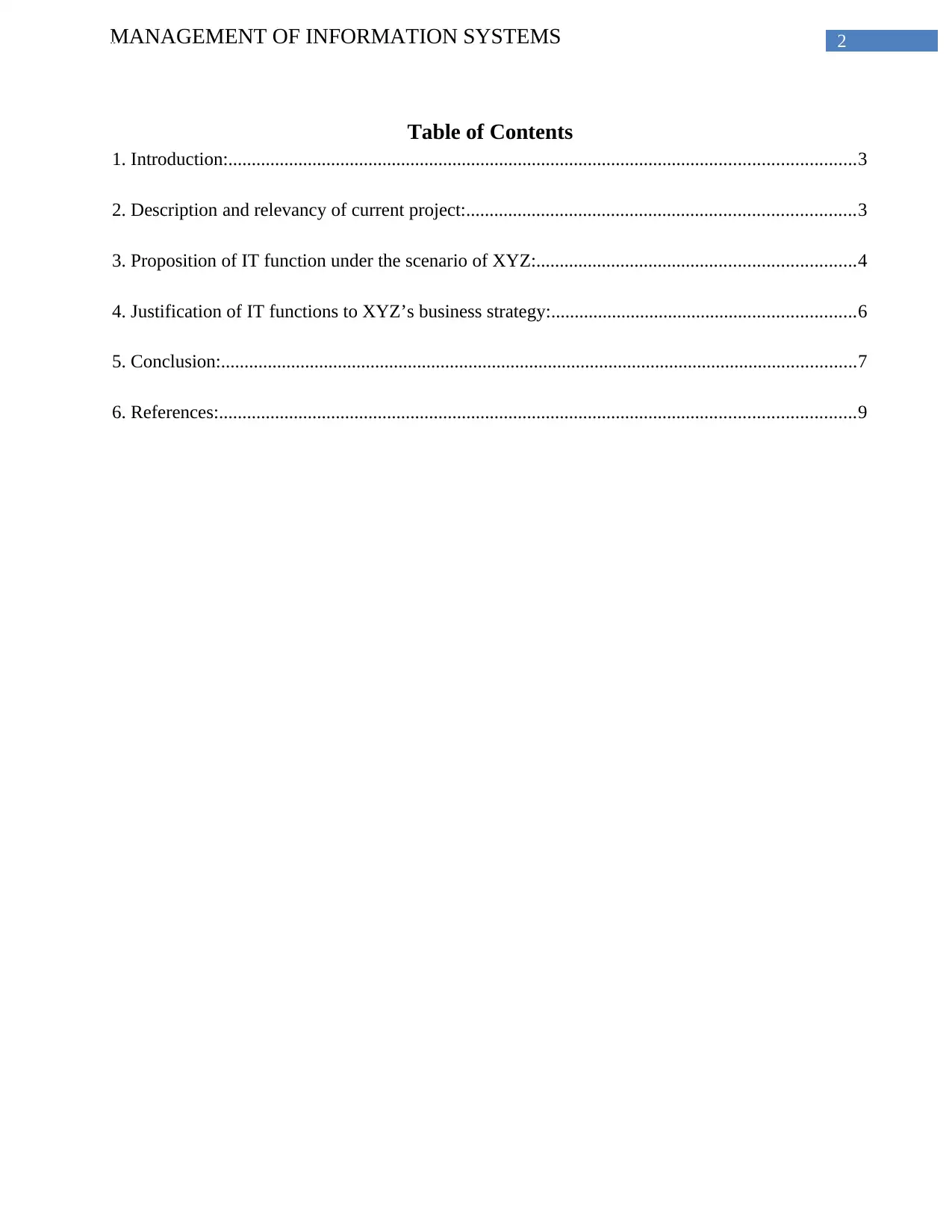
2MANAGEMENT OF INFORMATION SYSTEMS
Table of Contents
1. Introduction:......................................................................................................................................3
2. Description and relevancy of current project:...................................................................................3
3. Proposition of IT function under the scenario of XYZ:....................................................................4
4. Justification of IT functions to XYZ’s business strategy:.................................................................6
5. Conclusion:........................................................................................................................................7
6. References:........................................................................................................................................9
Table of Contents
1. Introduction:......................................................................................................................................3
2. Description and relevancy of current project:...................................................................................3
3. Proposition of IT function under the scenario of XYZ:....................................................................4
4. Justification of IT functions to XYZ’s business strategy:.................................................................6
5. Conclusion:........................................................................................................................................7
6. References:........................................................................................................................................9
⊘ This is a preview!⊘
Do you want full access?
Subscribe today to unlock all pages.

Trusted by 1+ million students worldwide
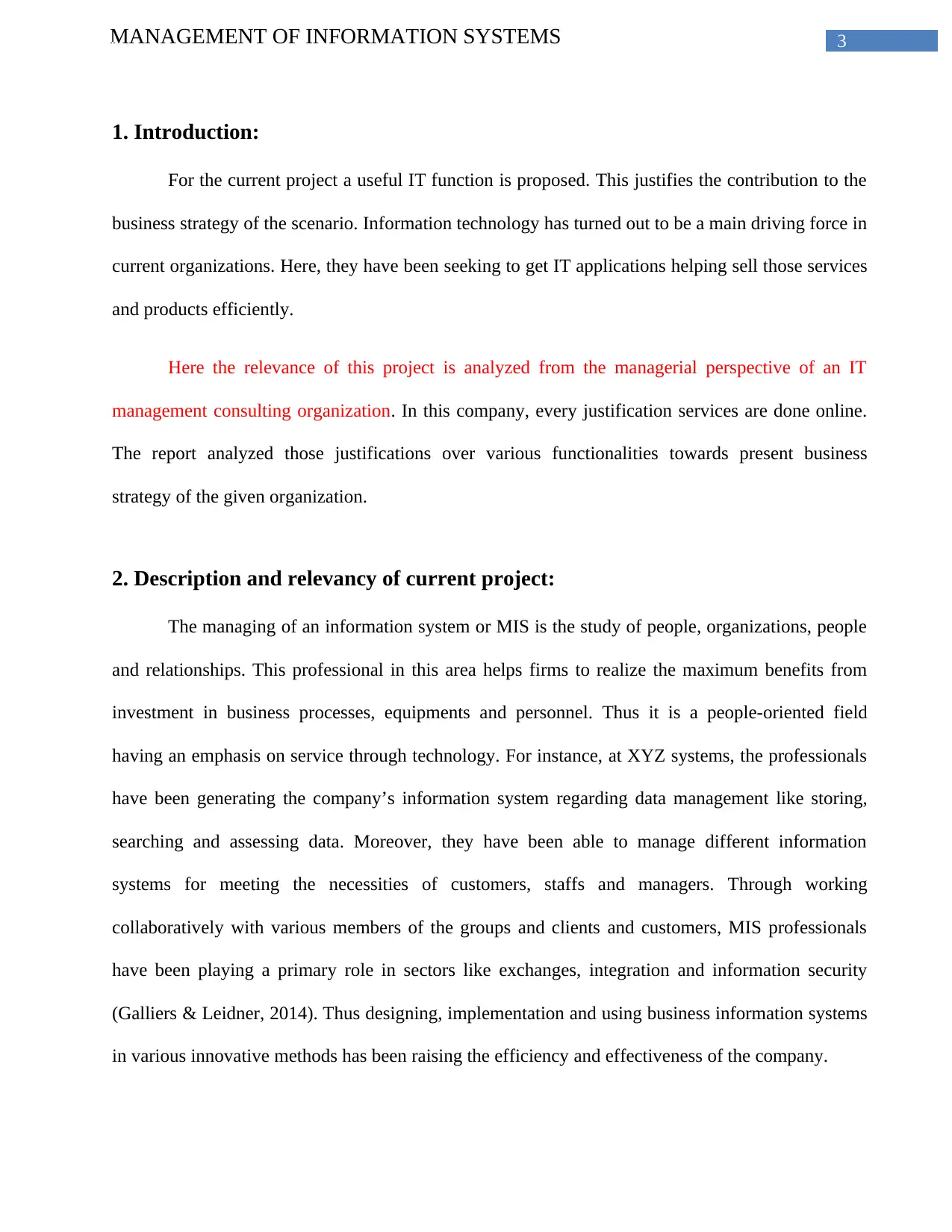
3MANAGEMENT OF INFORMATION SYSTEMS
1. Introduction:
For the current project a useful IT function is proposed. This justifies the contribution to the
business strategy of the scenario. Information technology has turned out to be a main driving force in
current organizations. Here, they have been seeking to get IT applications helping sell those services
and products efficiently.
Here the relevance of this project is analyzed from the managerial perspective of an IT
management consulting organization. In this company, every justification services are done online.
The report analyzed those justifications over various functionalities towards present business
strategy of the given organization.
2. Description and relevancy of current project:
The managing of an information system or MIS is the study of people, organizations, people
and relationships. This professional in this area helps firms to realize the maximum benefits from
investment in business processes, equipments and personnel. Thus it is a people-oriented field
having an emphasis on service through technology. For instance, at XYZ systems, the professionals
have been generating the company’s information system regarding data management like storing,
searching and assessing data. Moreover, they have been able to manage different information
systems for meeting the necessities of customers, staffs and managers. Through working
collaboratively with various members of the groups and clients and customers, MIS professionals
have been playing a primary role in sectors like exchanges, integration and information security
(Galliers & Leidner, 2014). Thus designing, implementation and using business information systems
in various innovative methods has been raising the efficiency and effectiveness of the company.
1. Introduction:
For the current project a useful IT function is proposed. This justifies the contribution to the
business strategy of the scenario. Information technology has turned out to be a main driving force in
current organizations. Here, they have been seeking to get IT applications helping sell those services
and products efficiently.
Here the relevance of this project is analyzed from the managerial perspective of an IT
management consulting organization. In this company, every justification services are done online.
The report analyzed those justifications over various functionalities towards present business
strategy of the given organization.
2. Description and relevancy of current project:
The managing of an information system or MIS is the study of people, organizations, people
and relationships. This professional in this area helps firms to realize the maximum benefits from
investment in business processes, equipments and personnel. Thus it is a people-oriented field
having an emphasis on service through technology. For instance, at XYZ systems, the professionals
have been generating the company’s information system regarding data management like storing,
searching and assessing data. Moreover, they have been able to manage different information
systems for meeting the necessities of customers, staffs and managers. Through working
collaboratively with various members of the groups and clients and customers, MIS professionals
have been playing a primary role in sectors like exchanges, integration and information security
(Galliers & Leidner, 2014). Thus designing, implementation and using business information systems
in various innovative methods has been raising the efficiency and effectiveness of the company.
Paraphrase This Document
Need a fresh take? Get an instant paraphrase of this document with our AI Paraphraser
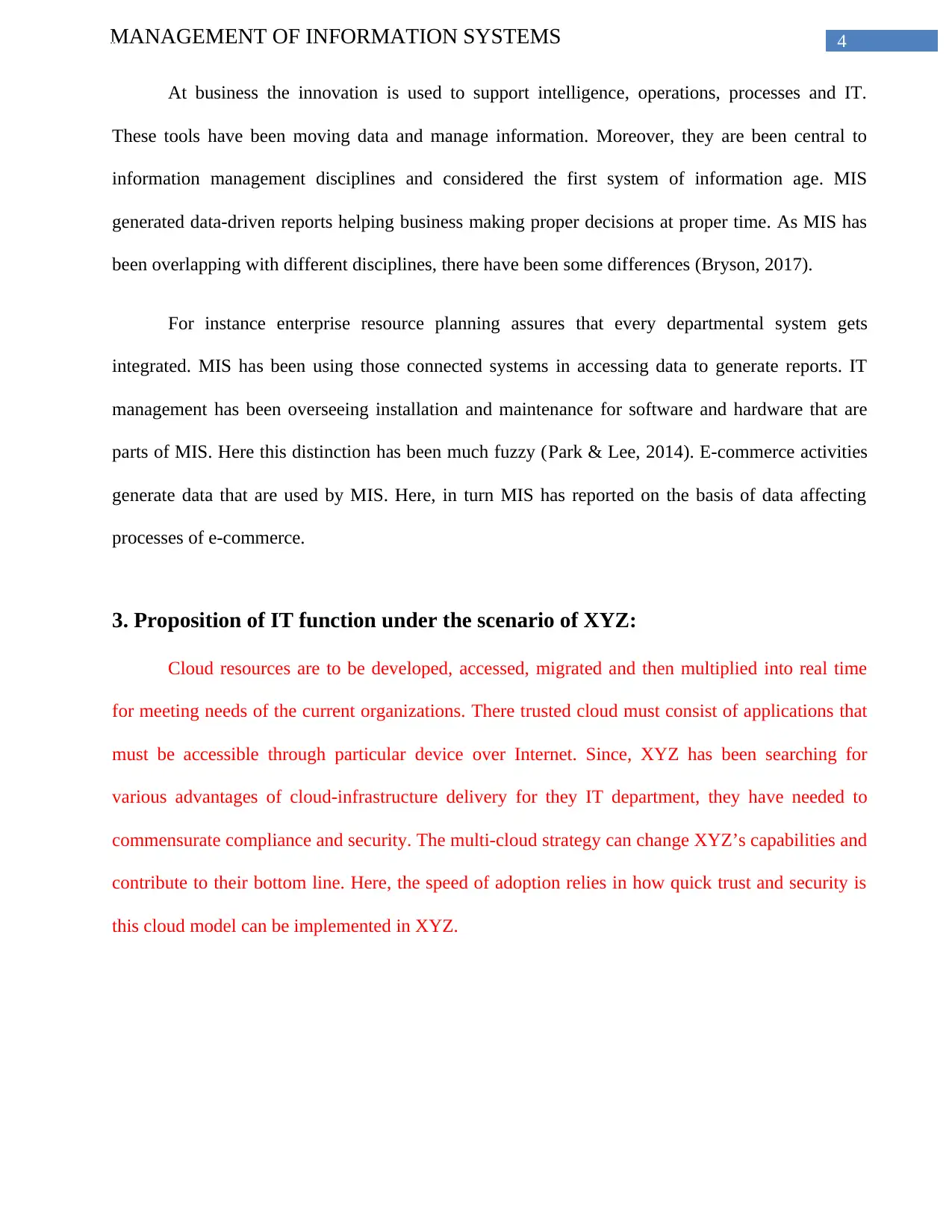
4MANAGEMENT OF INFORMATION SYSTEMS
At business the innovation is used to support intelligence, operations, processes and IT.
These tools have been moving data and manage information. Moreover, they are been central to
information management disciplines and considered the first system of information age. MIS
generated data-driven reports helping business making proper decisions at proper time. As MIS has
been overlapping with different disciplines, there have been some differences (Bryson, 2017).
For instance enterprise resource planning assures that every departmental system gets
integrated. MIS has been using those connected systems in accessing data to generate reports. IT
management has been overseeing installation and maintenance for software and hardware that are
parts of MIS. Here this distinction has been much fuzzy (Park & Lee, 2014). E-commerce activities
generate data that are used by MIS. Here, in turn MIS has reported on the basis of data affecting
processes of e-commerce.
3. Proposition of IT function under the scenario of XYZ:
Cloud resources are to be developed, accessed, migrated and then multiplied into real time
for meeting needs of the current organizations. There trusted cloud must consist of applications that
must be accessible through particular device over Internet. Since, XYZ has been searching for
various advantages of cloud-infrastructure delivery for they IT department, they have needed to
commensurate compliance and security. The multi-cloud strategy can change XYZ’s capabilities and
contribute to their bottom line. Here, the speed of adoption relies in how quick trust and security is
this cloud model can be implemented in XYZ.
At business the innovation is used to support intelligence, operations, processes and IT.
These tools have been moving data and manage information. Moreover, they are been central to
information management disciplines and considered the first system of information age. MIS
generated data-driven reports helping business making proper decisions at proper time. As MIS has
been overlapping with different disciplines, there have been some differences (Bryson, 2017).
For instance enterprise resource planning assures that every departmental system gets
integrated. MIS has been using those connected systems in accessing data to generate reports. IT
management has been overseeing installation and maintenance for software and hardware that are
parts of MIS. Here this distinction has been much fuzzy (Park & Lee, 2014). E-commerce activities
generate data that are used by MIS. Here, in turn MIS has reported on the basis of data affecting
processes of e-commerce.
3. Proposition of IT function under the scenario of XYZ:
Cloud resources are to be developed, accessed, migrated and then multiplied into real time
for meeting needs of the current organizations. There trusted cloud must consist of applications that
must be accessible through particular device over Internet. Since, XYZ has been searching for
various advantages of cloud-infrastructure delivery for they IT department, they have needed to
commensurate compliance and security. The multi-cloud strategy can change XYZ’s capabilities and
contribute to their bottom line. Here, the speed of adoption relies in how quick trust and security is
this cloud model can be implemented in XYZ.
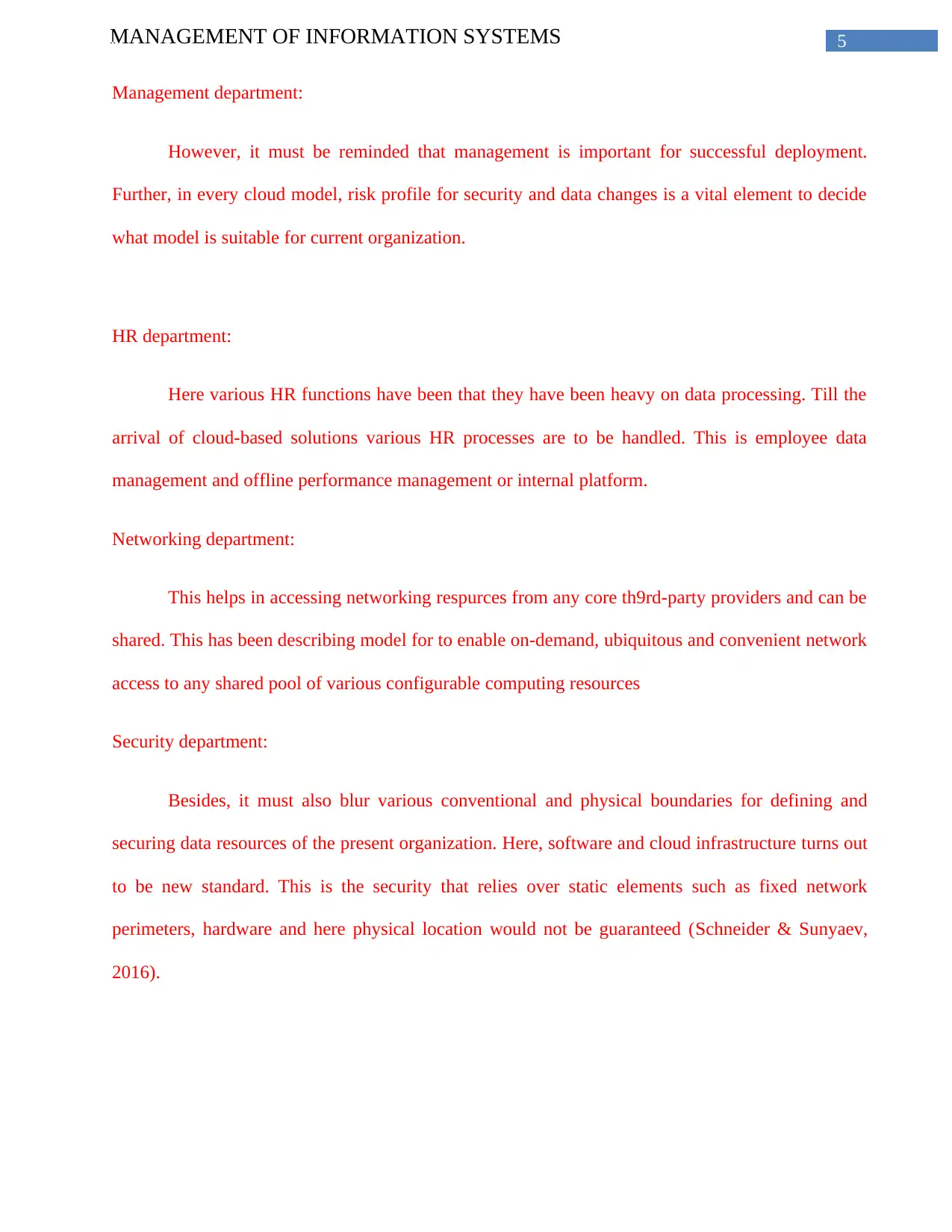
5MANAGEMENT OF INFORMATION SYSTEMS
Management department:
However, it must be reminded that management is important for successful deployment.
Further, in every cloud model, risk profile for security and data changes is a vital element to decide
what model is suitable for current organization.
HR department:
Here various HR functions have been that they have been heavy on data processing. Till the
arrival of cloud-based solutions various HR processes are to be handled. This is employee data
management and offline performance management or internal platform.
Networking department:
This helps in accessing networking respurces from any core th9rd-party providers and can be
shared. This has been describing model for to enable on-demand, ubiquitous and convenient network
access to any shared pool of various configurable computing resources
Security department:
Besides, it must also blur various conventional and physical boundaries for defining and
securing data resources of the present organization. Here, software and cloud infrastructure turns out
to be new standard. This is the security that relies over static elements such as fixed network
perimeters, hardware and here physical location would not be guaranteed (Schneider & Sunyaev,
2016).
Management department:
However, it must be reminded that management is important for successful deployment.
Further, in every cloud model, risk profile for security and data changes is a vital element to decide
what model is suitable for current organization.
HR department:
Here various HR functions have been that they have been heavy on data processing. Till the
arrival of cloud-based solutions various HR processes are to be handled. This is employee data
management and offline performance management or internal platform.
Networking department:
This helps in accessing networking respurces from any core th9rd-party providers and can be
shared. This has been describing model for to enable on-demand, ubiquitous and convenient network
access to any shared pool of various configurable computing resources
Security department:
Besides, it must also blur various conventional and physical boundaries for defining and
securing data resources of the present organization. Here, software and cloud infrastructure turns out
to be new standard. This is the security that relies over static elements such as fixed network
perimeters, hardware and here physical location would not be guaranteed (Schneider & Sunyaev,
2016).
⊘ This is a preview!⊘
Do you want full access?
Subscribe today to unlock all pages.

Trusted by 1+ million students worldwide
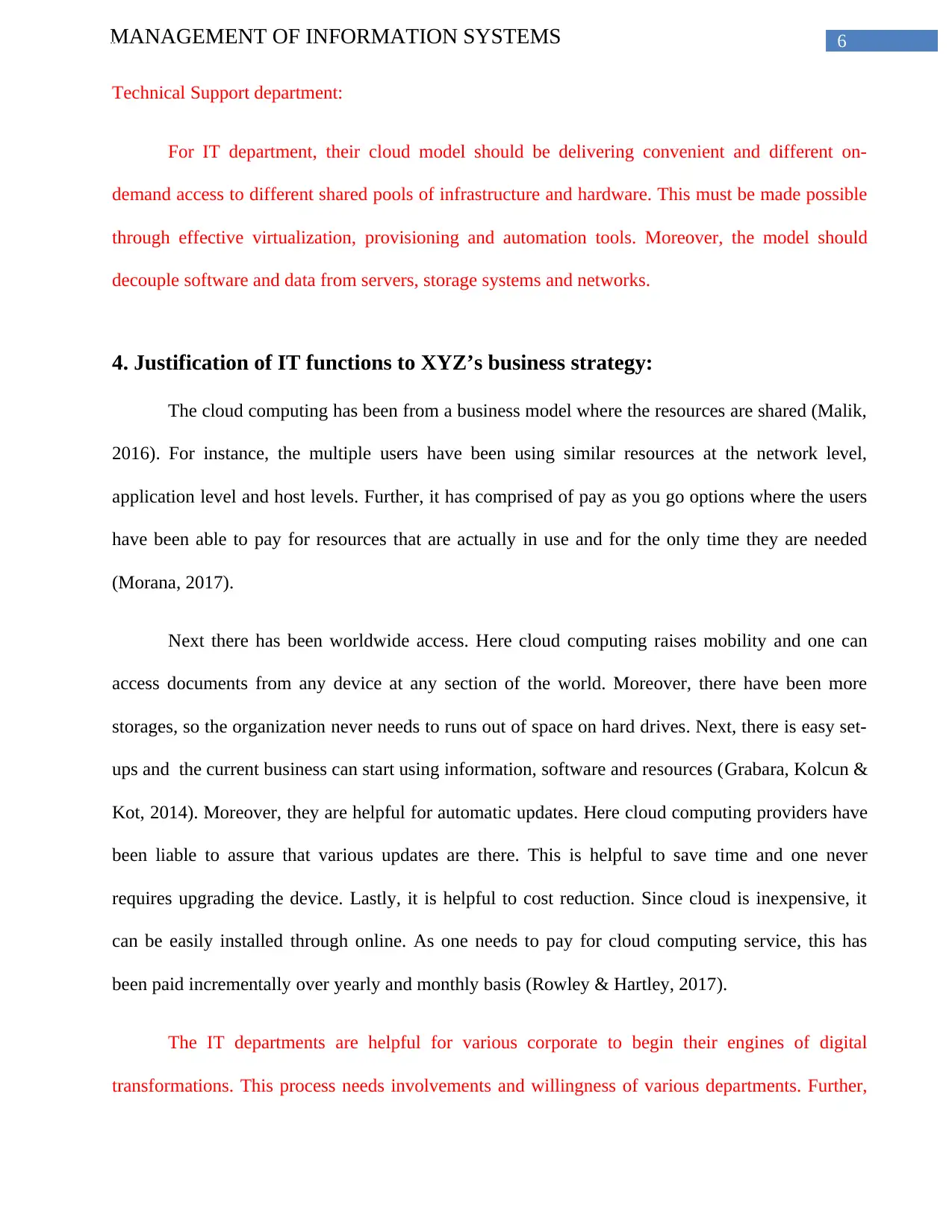
6MANAGEMENT OF INFORMATION SYSTEMS
Technical Support department:
For IT department, their cloud model should be delivering convenient and different on-
demand access to different shared pools of infrastructure and hardware. This must be made possible
through effective virtualization, provisioning and automation tools. Moreover, the model should
decouple software and data from servers, storage systems and networks.
4. Justification of IT functions to XYZ’s business strategy:
The cloud computing has been from a business model where the resources are shared (Malik,
2016). For instance, the multiple users have been using similar resources at the network level,
application level and host levels. Further, it has comprised of pay as you go options where the users
have been able to pay for resources that are actually in use and for the only time they are needed
(Morana, 2017).
Next there has been worldwide access. Here cloud computing raises mobility and one can
access documents from any device at any section of the world. Moreover, there have been more
storages, so the organization never needs to runs out of space on hard drives. Next, there is easy set-
ups and the current business can start using information, software and resources (Grabara, Kolcun &
Kot, 2014). Moreover, they are helpful for automatic updates. Here cloud computing providers have
been liable to assure that various updates are there. This is helpful to save time and one never
requires upgrading the device. Lastly, it is helpful to cost reduction. Since cloud is inexpensive, it
can be easily installed through online. As one needs to pay for cloud computing service, this has
been paid incrementally over yearly and monthly basis (Rowley & Hartley, 2017).
The IT departments are helpful for various corporate to begin their engines of digital
transformations. This process needs involvements and willingness of various departments. Further,
Technical Support department:
For IT department, their cloud model should be delivering convenient and different on-
demand access to different shared pools of infrastructure and hardware. This must be made possible
through effective virtualization, provisioning and automation tools. Moreover, the model should
decouple software and data from servers, storage systems and networks.
4. Justification of IT functions to XYZ’s business strategy:
The cloud computing has been from a business model where the resources are shared (Malik,
2016). For instance, the multiple users have been using similar resources at the network level,
application level and host levels. Further, it has comprised of pay as you go options where the users
have been able to pay for resources that are actually in use and for the only time they are needed
(Morana, 2017).
Next there has been worldwide access. Here cloud computing raises mobility and one can
access documents from any device at any section of the world. Moreover, there have been more
storages, so the organization never needs to runs out of space on hard drives. Next, there is easy set-
ups and the current business can start using information, software and resources (Grabara, Kolcun &
Kot, 2014). Moreover, they are helpful for automatic updates. Here cloud computing providers have
been liable to assure that various updates are there. This is helpful to save time and one never
requires upgrading the device. Lastly, it is helpful to cost reduction. Since cloud is inexpensive, it
can be easily installed through online. As one needs to pay for cloud computing service, this has
been paid incrementally over yearly and monthly basis (Rowley & Hartley, 2017).
The IT departments are helpful for various corporate to begin their engines of digital
transformations. This process needs involvements and willingness of various departments. Further,
Paraphrase This Document
Need a fresh take? Get an instant paraphrase of this document with our AI Paraphraser
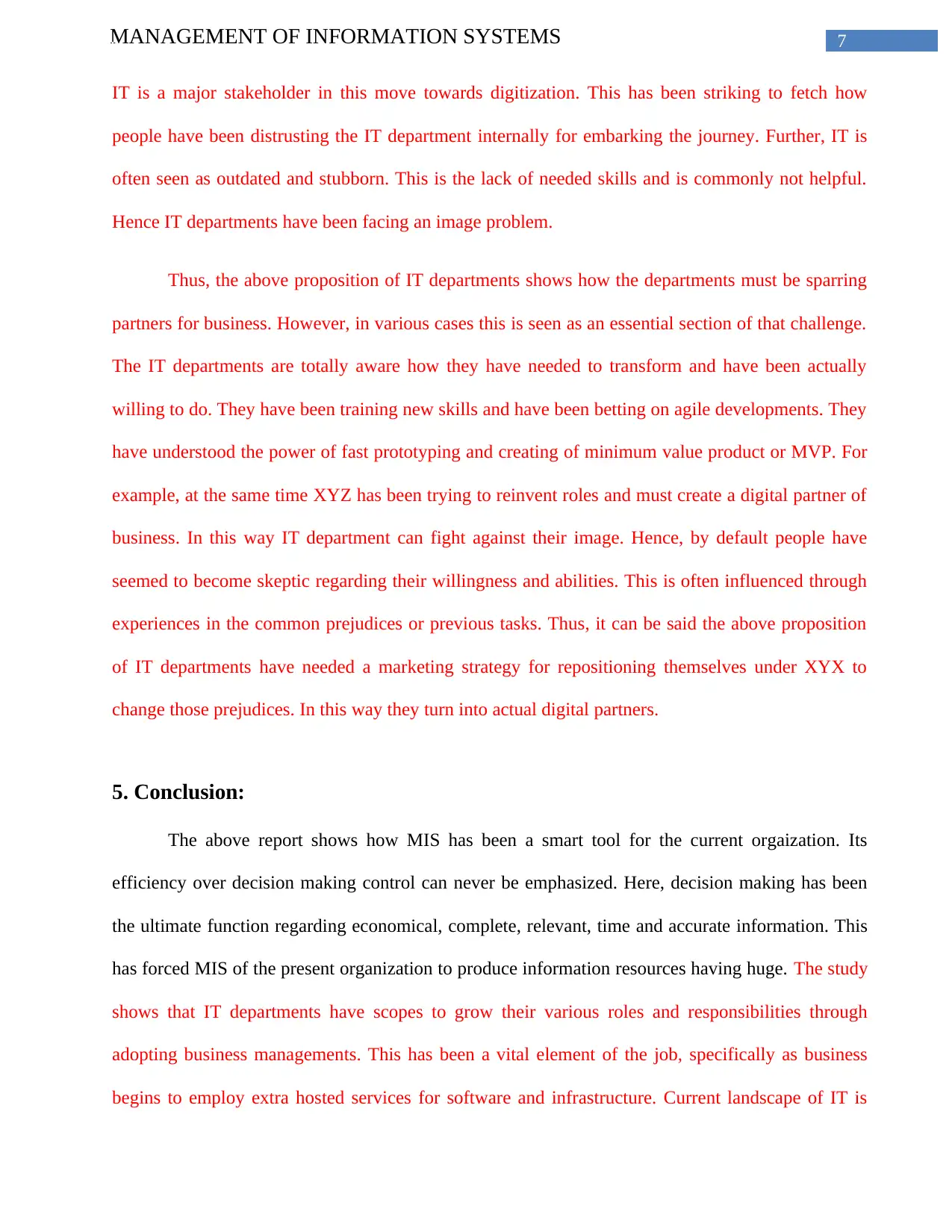
7MANAGEMENT OF INFORMATION SYSTEMS
IT is a major stakeholder in this move towards digitization. This has been striking to fetch how
people have been distrusting the IT department internally for embarking the journey. Further, IT is
often seen as outdated and stubborn. This is the lack of needed skills and is commonly not helpful.
Hence IT departments have been facing an image problem.
Thus, the above proposition of IT departments shows how the departments must be sparring
partners for business. However, in various cases this is seen as an essential section of that challenge.
The IT departments are totally aware how they have needed to transform and have been actually
willing to do. They have been training new skills and have been betting on agile developments. They
have understood the power of fast prototyping and creating of minimum value product or MVP. For
example, at the same time XYZ has been trying to reinvent roles and must create a digital partner of
business. In this way IT department can fight against their image. Hence, by default people have
seemed to become skeptic regarding their willingness and abilities. This is often influenced through
experiences in the common prejudices or previous tasks. Thus, it can be said the above proposition
of IT departments have needed a marketing strategy for repositioning themselves under XYX to
change those prejudices. In this way they turn into actual digital partners.
5. Conclusion:
The above report shows how MIS has been a smart tool for the current orgaization. Its
efficiency over decision making control can never be emphasized. Here, decision making has been
the ultimate function regarding economical, complete, relevant, time and accurate information. This
has forced MIS of the present organization to produce information resources having huge. The study
shows that IT departments have scopes to grow their various roles and responsibilities through
adopting business managements. This has been a vital element of the job, specifically as business
begins to employ extra hosted services for software and infrastructure. Current landscape of IT is
IT is a major stakeholder in this move towards digitization. This has been striking to fetch how
people have been distrusting the IT department internally for embarking the journey. Further, IT is
often seen as outdated and stubborn. This is the lack of needed skills and is commonly not helpful.
Hence IT departments have been facing an image problem.
Thus, the above proposition of IT departments shows how the departments must be sparring
partners for business. However, in various cases this is seen as an essential section of that challenge.
The IT departments are totally aware how they have needed to transform and have been actually
willing to do. They have been training new skills and have been betting on agile developments. They
have understood the power of fast prototyping and creating of minimum value product or MVP. For
example, at the same time XYZ has been trying to reinvent roles and must create a digital partner of
business. In this way IT department can fight against their image. Hence, by default people have
seemed to become skeptic regarding their willingness and abilities. This is often influenced through
experiences in the common prejudices or previous tasks. Thus, it can be said the above proposition
of IT departments have needed a marketing strategy for repositioning themselves under XYX to
change those prejudices. In this way they turn into actual digital partners.
5. Conclusion:
The above report shows how MIS has been a smart tool for the current orgaization. Its
efficiency over decision making control can never be emphasized. Here, decision making has been
the ultimate function regarding economical, complete, relevant, time and accurate information. This
has forced MIS of the present organization to produce information resources having huge. The study
shows that IT departments have scopes to grow their various roles and responsibilities through
adopting business managements. This has been a vital element of the job, specifically as business
begins to employ extra hosted services for software and infrastructure. Current landscape of IT is
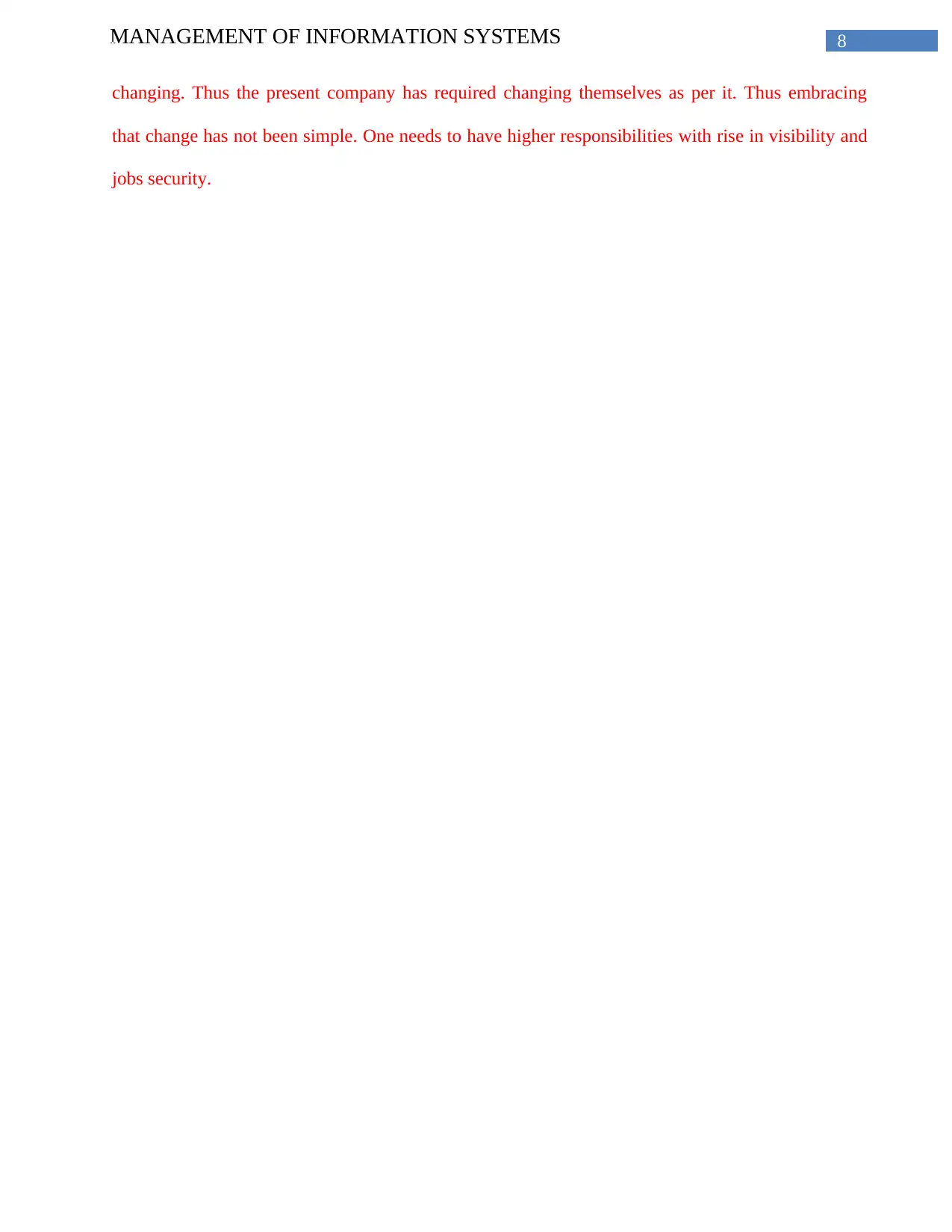
8MANAGEMENT OF INFORMATION SYSTEMS
changing. Thus the present company has required changing themselves as per it. Thus embracing
that change has not been simple. One needs to have higher responsibilities with rise in visibility and
jobs security.
changing. Thus the present company has required changing themselves as per it. Thus embracing
that change has not been simple. One needs to have higher responsibilities with rise in visibility and
jobs security.
⊘ This is a preview!⊘
Do you want full access?
Subscribe today to unlock all pages.

Trusted by 1+ million students worldwide
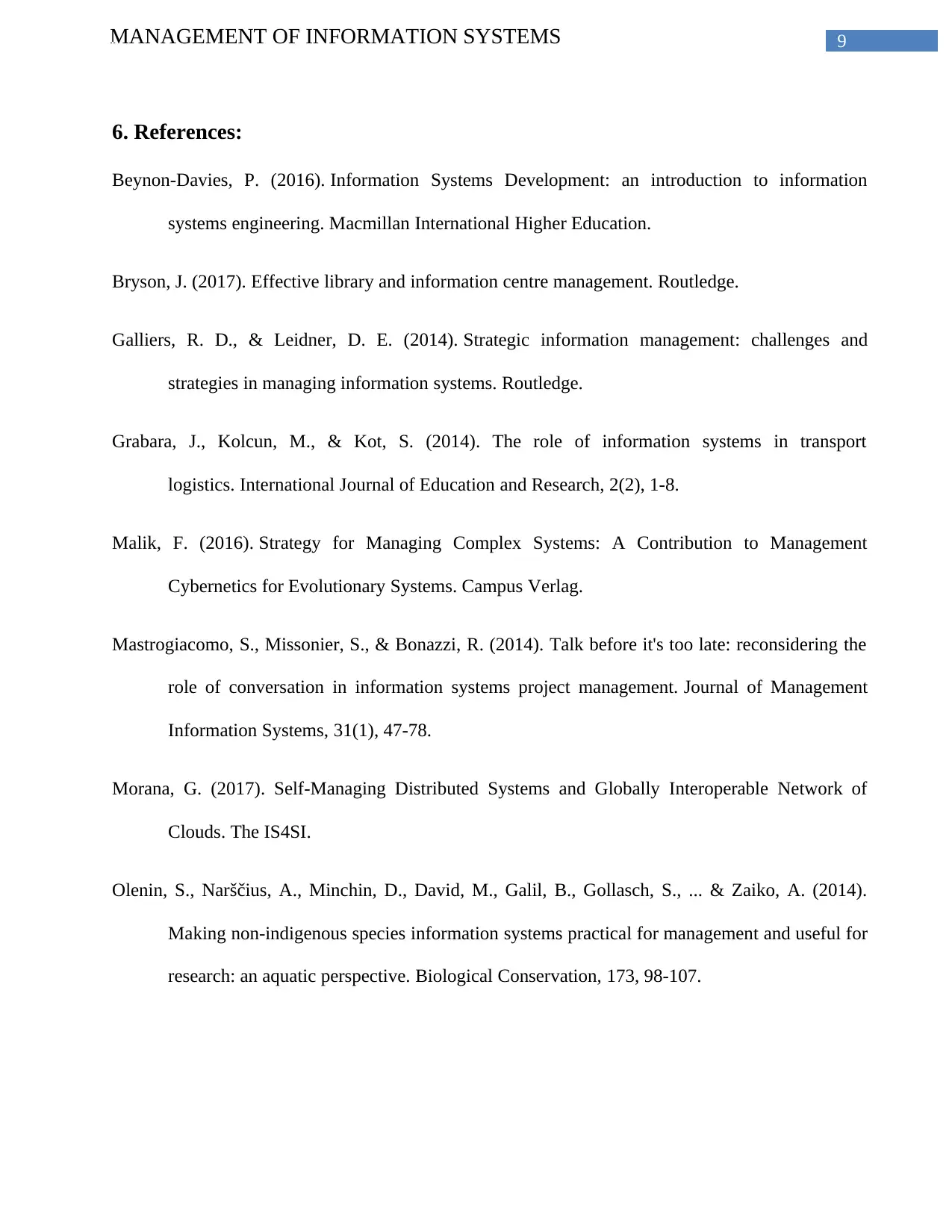
9MANAGEMENT OF INFORMATION SYSTEMS
6. References:
Beynon-Davies, P. (2016). Information Systems Development: an introduction to information
systems engineering. Macmillan International Higher Education.
Bryson, J. (2017). Effective library and information centre management. Routledge.
Galliers, R. D., & Leidner, D. E. (2014). Strategic information management: challenges and
strategies in managing information systems. Routledge.
Grabara, J., Kolcun, M., & Kot, S. (2014). The role of information systems in transport
logistics. International Journal of Education and Research, 2(2), 1-8.
Malik, F. (2016). Strategy for Managing Complex Systems: A Contribution to Management
Cybernetics for Evolutionary Systems. Campus Verlag.
Mastrogiacomo, S., Missonier, S., & Bonazzi, R. (2014). Talk before it's too late: reconsidering the
role of conversation in information systems project management. Journal of Management
Information Systems, 31(1), 47-78.
Morana, G. (2017). Self-Managing Distributed Systems and Globally Interoperable Network of
Clouds. The IS4SI.
Olenin, S., Narščius, A., Minchin, D., David, M., Galil, B., Gollasch, S., ... & Zaiko, A. (2014).
Making non-indigenous species information systems practical for management and useful for
research: an aquatic perspective. Biological Conservation, 173, 98-107.
6. References:
Beynon-Davies, P. (2016). Information Systems Development: an introduction to information
systems engineering. Macmillan International Higher Education.
Bryson, J. (2017). Effective library and information centre management. Routledge.
Galliers, R. D., & Leidner, D. E. (2014). Strategic information management: challenges and
strategies in managing information systems. Routledge.
Grabara, J., Kolcun, M., & Kot, S. (2014). The role of information systems in transport
logistics. International Journal of Education and Research, 2(2), 1-8.
Malik, F. (2016). Strategy for Managing Complex Systems: A Contribution to Management
Cybernetics for Evolutionary Systems. Campus Verlag.
Mastrogiacomo, S., Missonier, S., & Bonazzi, R. (2014). Talk before it's too late: reconsidering the
role of conversation in information systems project management. Journal of Management
Information Systems, 31(1), 47-78.
Morana, G. (2017). Self-Managing Distributed Systems and Globally Interoperable Network of
Clouds. The IS4SI.
Olenin, S., Narščius, A., Minchin, D., David, M., Galil, B., Gollasch, S., ... & Zaiko, A. (2014).
Making non-indigenous species information systems practical for management and useful for
research: an aquatic perspective. Biological Conservation, 173, 98-107.
Paraphrase This Document
Need a fresh take? Get an instant paraphrase of this document with our AI Paraphraser
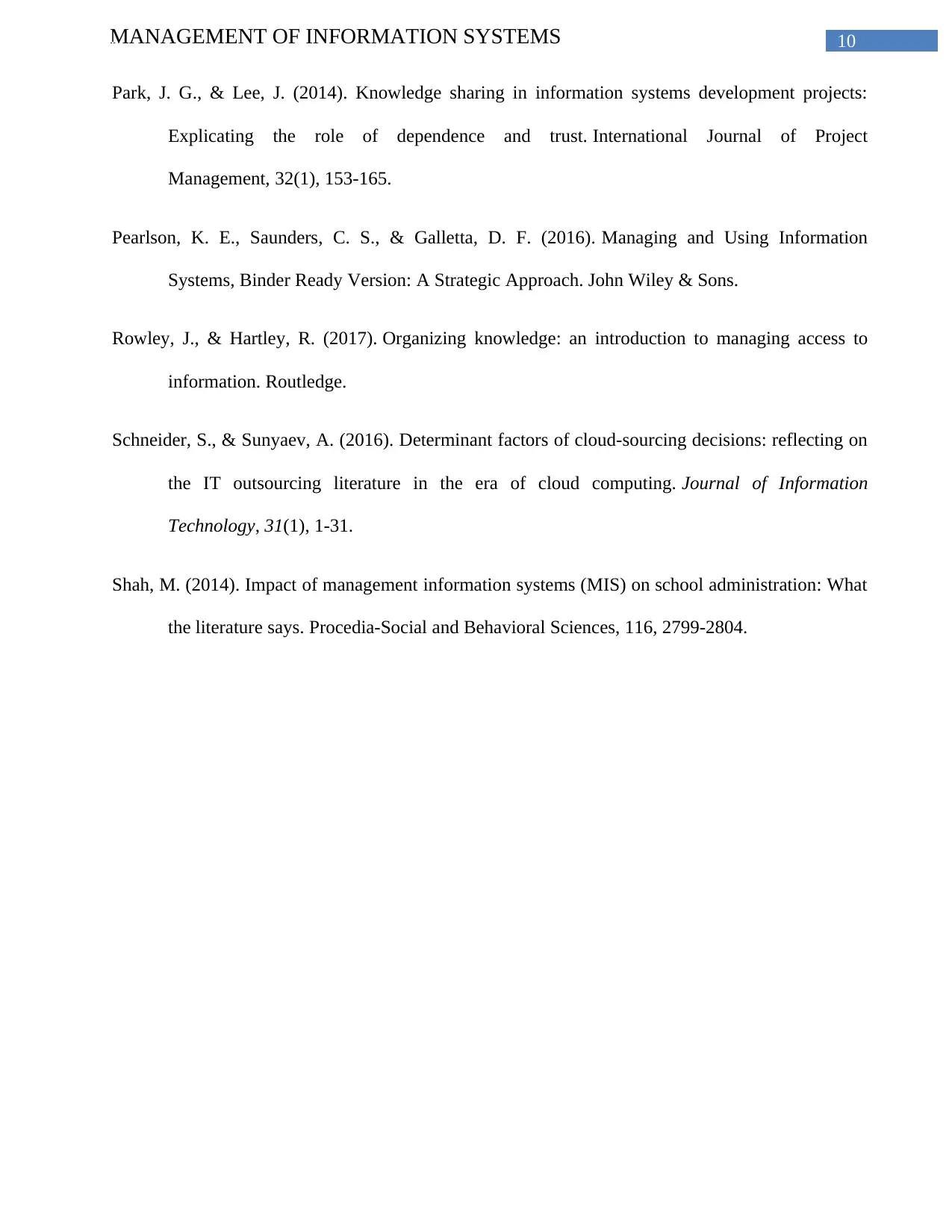
10MANAGEMENT OF INFORMATION SYSTEMS
Park, J. G., & Lee, J. (2014). Knowledge sharing in information systems development projects:
Explicating the role of dependence and trust. International Journal of Project
Management, 32(1), 153-165.
Pearlson, K. E., Saunders, C. S., & Galletta, D. F. (2016). Managing and Using Information
Systems, Binder Ready Version: A Strategic Approach. John Wiley & Sons.
Rowley, J., & Hartley, R. (2017). Organizing knowledge: an introduction to managing access to
information. Routledge.
Schneider, S., & Sunyaev, A. (2016). Determinant factors of cloud-sourcing decisions: reflecting on
the IT outsourcing literature in the era of cloud computing. Journal of Information
Technology, 31(1), 1-31.
Shah, M. (2014). Impact of management information systems (MIS) on school administration: What
the literature says. Procedia-Social and Behavioral Sciences, 116, 2799-2804.
Park, J. G., & Lee, J. (2014). Knowledge sharing in information systems development projects:
Explicating the role of dependence and trust. International Journal of Project
Management, 32(1), 153-165.
Pearlson, K. E., Saunders, C. S., & Galletta, D. F. (2016). Managing and Using Information
Systems, Binder Ready Version: A Strategic Approach. John Wiley & Sons.
Rowley, J., & Hartley, R. (2017). Organizing knowledge: an introduction to managing access to
information. Routledge.
Schneider, S., & Sunyaev, A. (2016). Determinant factors of cloud-sourcing decisions: reflecting on
the IT outsourcing literature in the era of cloud computing. Journal of Information
Technology, 31(1), 1-31.
Shah, M. (2014). Impact of management information systems (MIS) on school administration: What
the literature says. Procedia-Social and Behavioral Sciences, 116, 2799-2804.
1 out of 11
Related Documents
Your All-in-One AI-Powered Toolkit for Academic Success.
+13062052269
info@desklib.com
Available 24*7 on WhatsApp / Email
![[object Object]](/_next/static/media/star-bottom.7253800d.svg)
Unlock your academic potential
Copyright © 2020–2025 A2Z Services. All Rights Reserved. Developed and managed by ZUCOL.





